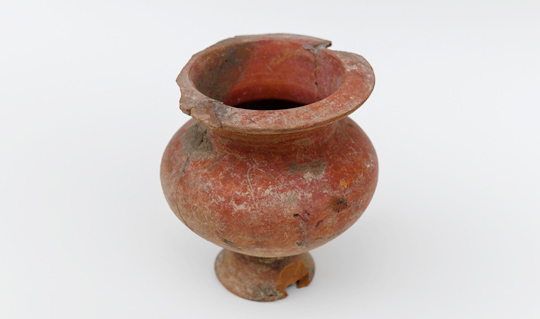From Ancient Lydia to a Modern Wardrobe
Freiburg, Aug 10, 2018
Once in a while, historical objects are donated as gifts to the Archaeological Collection of the University of Freiburg. Quite often, these are valuable artifacts. In this series, we present the most beautiful and extraordinary acquisitions. This time, we take a closer look at an ancient Greek lydion, which is a kind of vessel that may have been used for storing ointment.

This lydion has many gaps and cracks that most likely occurred after its discovery. The pieces still need to be reassembled by a conservator. Photo: Patrick Seeger
The name “lydion” comes from Lydia, which was an ancient country in the western part of Asia Minor, where the Indo-European Lydians lived from the 12th to the 3rd century BC. It is a kind of vessel thought to have been used for storing ointment. The ancient Greeks were admirers of the lydion, and after they adopted this style of vessel, it became very popular in the eastern part of Greece. In 2014, Kirsten König donated a lydion to the Archaeological Collection.
Gaps and cracks
“I inherited the vessel from my mother. After she died two years ago, we found it in the back of a wardrobe. It had probably been there for more than 50 years,” says Ms. König, who is 65 and from Opfingen. König’s parents had received the lydion as gift from a family they got to know while on holiday in Italy. “I recognized right away that it is a very old artifact, and I thought it would be better kept at the Archaeological Collection than at home.”
Dr. Jens-Arne Dickmann, the curator of the Archaeological Collection, was especially pleased about this donation. Unlike other antique ceramics, lydions are not typically found in smaller collections. “Judging by the color of the clay – a bright red – this vessel is probably not from Greece, but from Asia Minor,” says Dickmann, adding that the artifact could be from a gravesite. “That could explain the impurities on the exterior walls of the vessel. The gaps and cracks that have been provisionally glued together are likely to be from a later date, after antiquity.” The gap appears modern and to have occurred after the object was found, which was not very long ago. “The pieces still need to be reassembled by a conservator, but unfortunately we don’t have one working in our collection,” says Dickmann.
A special educational object
What could have been the purpose of this vessel? “Lydions were commonly used as vessels for ointment, although they have a comparatively large opening,” explains Dickmann. Its form and wide curved rim indicates that is not a drinking vessel, and simple vessels with lids were used for dry goods. “That’s why I think it’s most likely that this vessel was used for ointments.” With its distinct form and origin, the object is wonderfully suited for teaching students how to describe and identify artifacts – and it is an excellent drawing model. “With regard to its preservation, we can theorize about how it first survived in a grave for centuries, how it was discovered, how it was sold on the art market or became private property, and finally how it was donated to a public academic institution.”
Hans-Dieter Fronz

